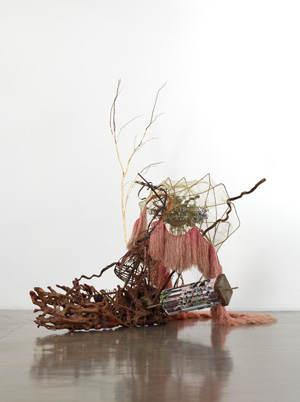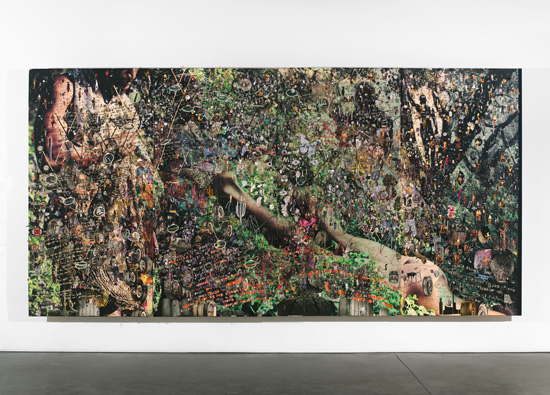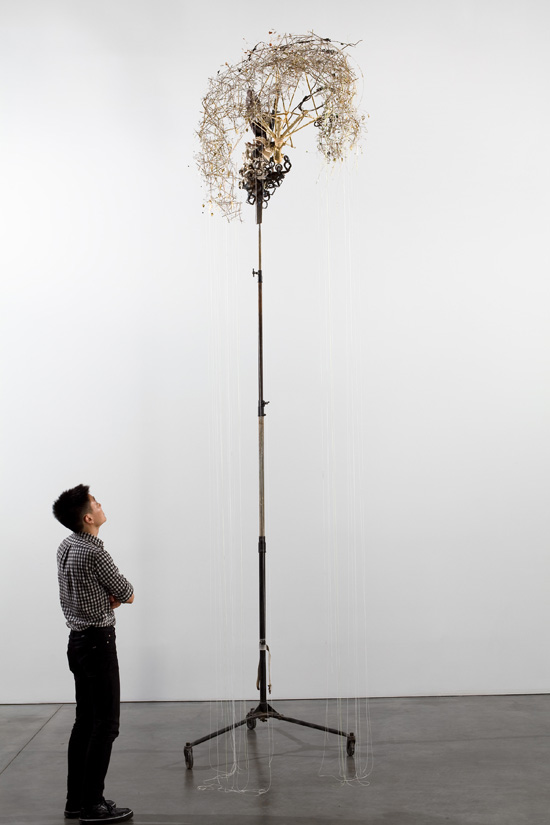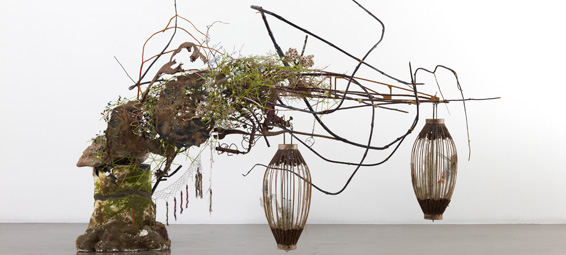Even if you’ve seen them only from photographs, it’s clear that the objects in Elliott Hundley: The Bacchae are stunning works of art. Their complexity practically defies description, and the range of materials is remarkable. Tearing flesh from the bone (2011), for example, is made from wood, metal, plastic, rope, found upholstery coils, goat hooves, metal leafing, pine cones, lobster legs, feathers, and epoxy. Hundley’s project is based on Euripides’ fifth-century B.C. play in which Dionysus, god of wine and fertility rituals, takes revenge on his human kin for failing to recognize his divine status. The Bacchae are the women of Thebes, whom Dionysus leads into ecstatic madness with ultimately destructive results.
Some of Hundley’s works are titled after characters, such as Pentheus (2010), Dionysus’ ill-fated mortal cousin and king of Thebes, or epithets, like the Lightning’s Bride (2011), for Dionysus’ mother Semele, who was incinerated by Zeus-as-thunderbolt, her lover and Dionysus’ father. Others, like eyes that run like leaping fire (2011), refer to images from the play, in this case the madness of Agave as she kills and dismembers Pentheus, her son. In all cases, the sheer bewildering multiplicity of materials can only be called Dionysian. The exhibition, organized by the Wexner Center’s prolific Christopher Bedford, includes three epic collages, eight assemblages, and one oil on linen painting after De Chirico.

Part of the intensity of Hundley’s work comes from its use of visionary, non-rational techniques, such as sticking pins into surfaces, obsessive repetition of motifs, and spelling out words ransom note-style from separately cut-out letters. These techniques are more commonly associated with artists who have had some psychologically irregular experience, such as Yayoi Kusama, who has lived in a mental hospital since 1975, or Jess, who abandoned his career as a military chemist after an apocalyptic dream that foretold the earth’s destruction in a nuclear apocalypse, devoting the rest of his life to making visionary “paste-ups” that resemble Hundley’s work in their use of countless individual cut-out fragments to create one vast visual field. (In fact, a good point of formal comparison would be Jess’s Arkadia’s Last Resort; or, Fête champêtre Up Mnemosyne Creek, from 1976, in the DMA’s permanent collection). Although such experience isn’t part of Hundley’s autobiographical presentation, one could very well argue that it is functionally parallel to the Dionysian frenzies that form the thematic core of the Bacchae.
As part of Hundley’s practice, friends and collaborators dress in costume and pose for photographs as characters from the dramas. In the present exhibition, that aspect of the work is somewhat deemphasized, by comparison with a 2009 exhibition of “Hekabe.” Then, Hundley introduced the “players” individually by mounting individual photographs on light boxes at the entrance, so that their reappearance within the larger collages would be recognizable. Here, without such an introduction, we may be able to spot the players’ cutout photos among the many other elements of the collages, but don’t necessarily recognize their identity.

Almost all of the works are contained within the first gallery to the right of the Nasher’s entrance, with the exception of her house smoldering (2011), which commands the space beyond the admission desk. In the exhibition gallery, three vertical assemblages, each entitled thyrsus after the pine-cone-tipped staff and fertility symbol carried by the Bacchic maenads, have the central position. The remaining assemblages are framed by the three wall-mounted collages and the lone painting. Count me as a pretty much unqualified admirer of the Nasher building and galleries; nevertheless, I can’t help but wonder if architect Renzo Piano is too Apollonian for a Dionysian such as Hundley. If I had to imagine the most sympathetic environment for his works, it might be a mannerist garden grotto, or the set of a Tim Burton film. On the other hand, the tension between Piano’s and Hundley’s sensibilities is interesting.
At the level of sheer overwhelming density of material, Hundley’s work inspires the same sense of awe as a Mark Bradford or a Julie Mehretu. As for what the work is telling us about Euripides or the Dionysian mysteries, that’s less immediately obvious, but much worth considering. Concerning process and context, many answers promise to be found in the accompanying catalog, which includes four essays and 95 color photographs.






